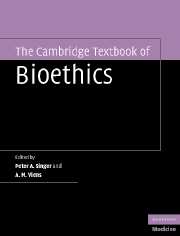Book contents
- Frontmatter
- Contents
- List of contributors
- Acknowledgements
- 1 Introduction
- Section I Information problems
- Section II End of life care
- Section III Pregnant women and children
- Section IV Genetics and biotechnology
- Introduction
- 20 Organ transplantation
- 21 Regenerative medicine
- 22 Genetic testing and screening
- 23 Bio-banking
- 24 Behavioral genetics
- Section V Research ethics
- Section VI Health systems and institutions
- Section VII Using clinical ethics to make an impact in healthcare
- Section VIII Global health ethics
- Section IX Religious and cultural perspectives in bioethics
- Section X Specialty bioethics
- Index
- References
23 - Bio-banking
Published online by Cambridge University Press: 30 October 2009
- Frontmatter
- Contents
- List of contributors
- Acknowledgements
- 1 Introduction
- Section I Information problems
- Section II End of life care
- Section III Pregnant women and children
- Section IV Genetics and biotechnology
- Introduction
- 20 Organ transplantation
- 21 Regenerative medicine
- 22 Genetic testing and screening
- 23 Bio-banking
- 24 Behavioral genetics
- Section V Research ethics
- Section VI Health systems and institutions
- Section VII Using clinical ethics to make an impact in healthcare
- Section VIII Global health ethics
- Section IX Religious and cultural perspectives in bioethics
- Section X Specialty bioethics
- Index
- References
Summary
For many years, physicians at a cancer clinic have been storing biological samples left over after being used for diagnosis in clinical testing. Prior to 2000, no consent for storage or research was obtained. In 2000, the clinic changed its policy and began to systematically request consent for the use and storage of leftover biological samples “for future cancer research.” From that point on, the clinic has been storing samples only when the patient consented. It discards samples when the patient does not consent. Many of the sample donors are still alive (some are still patients at the clinic), while others have died. The clinic now has over 4000 samples, with comprehensive clinical data. Two groups of geneticists would like to use the samples for research, one examining the genetic basis of certain cancers, and the other examining the genetic basis of ethnicity and drug response in a randomized, heterogeneous population study.
What is bio-banking?
Our knowledge of genetics has largely transformed the manner in which biomedical research takes place. From the Human Genome Project and the International HapMap Consortium, we now know the sequence of the human genome, and we have created a haplotype map of the human genome, describing the common patterns of haplotype ancestry.
- Type
- Chapter
- Information
- The Cambridge Textbook of Bioethics , pp. 166 - 173Publisher: Cambridge University PressPrint publication year: 2008
References
- 3
- Cited by



